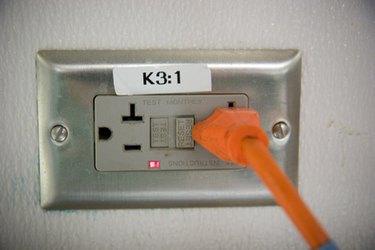Things You'll Need
Fuse box or circuit breaker
Assorted GFCI outlets
Electrical wiring
Appliances

A ground fault circuit interrupter, or GFCI, receptacle is an outlet designed to prevent electrical shocks in areas of homes and businesses at which the possibility of such accidents is high, such as bathrooms, kitchens and swimming pools. These safety devices, required by the National Electric Code, sense a spike in current and shut down to prevent accidental shock. Selection of proper receptacles is dependent on the type and amperage of appliances plugged into the outlet, as well as the building's overall electrical system.
Three Different GFCIs
Step 1
Locate the building's electrical panel box. Determine whether the building's electrical supply is regulated by fuses or by circuit breakers. Select wall receptacle GFCIs for fuse boxes, while circuit breakers GFCIs must be installed directly into the circuit breaker box. Wall receptacle units provide reset function at the point of use and are less expensive. Circuit breaker units provide protection for a greater number of outlets.
Video of the Day
Step 2
Determine the current amperage requirements. Look at existing receptacles. The 15-amp receptacles have two slots and a U-shaped grounding hole. A 14-gauge wire will serve the outlet.
The 20-amp receptacles have a horizontal slot branching off of a vertical slot. These are served by 10-gauge or 12-gauge wires. Check the plugs of existing appliances, such as microwaves or washing machines, for extra clues on amperage requirements.
Step 3
For outdoor applications, determine the amp requirements first. Choose a portable GFCI for an area in which there is no permanent electrical connection. Two types are available. One type houses GFCI components in a self-contained enclosure, which in turn plugs into a standard receptacle. The other type combines a traditional extension cord with a GFCI receptacle, providing more flexibility.
Tip
Outdoor GFCI receptacles may be combined with weather-resistant enclosures for additional protection.
In areas frequented by children, install tamper-resistant features to further decrease the chances of electrical shock.
The 15-amp plugs can work in 20-amp receptacles but 20-amp plugs will not work in 15-amp receptacles.
Warning
Homeowners uncertain about the type of electrical devices used in their homes should consult an electrician to avoid purchasing or installing improper GFCI outlets.
Video of the Day